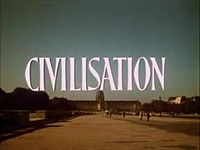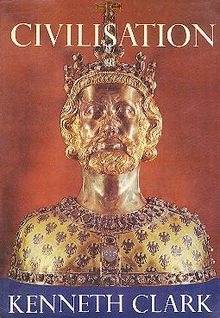- Civilisation (TV series)
-
Civilisation 
Title card from Episode 1,
"The Skin of Our Teeth"Also known as Civilisation: A Personal View by Kenneth Clark Genre Documentary Developed by David Attenborough Presented by Kenneth Clark Composer(s) Edwin Astley Country of origin United Kingdom Language(s) English No. of episodes 13 Production Producer(s) Michael Gill
Peter MontagnonRunning time 50 minutes Broadcast Picture format 4:3 Audio format Mono First shown in BBC2 Original run 23 February 1969 – 18 May 1969 Civilisation — in full Civilisation: A Personal View by Kenneth Clark — is a television documentary series outlining the history of Western art, architecture and philosophy since the Dark Ages. The series was produced by the BBC and aired in 1969 on BBC2. Both the television material and an accompanying book were written by art historian Kenneth Clark (1903–1983), who also presented the series. The series is considered to be a landmark in British Television's broadcasting of the visual arts.[1]
In January 2011 it was reported that the BBC had remastered the original film into HD. The series was then re-broadcast on the BBC HD channel from 9 February to 4 May 2011.[2][3]
Contents
Production
Civilisation was one of the first United Kingdom television documentary series made in colour, commissioned during David Attenborough's controllership of BBC2. For technical reasons, colour television was to come to BBC2 before BBC1 and, as a channel aimed at minority audiences, it was appropriate to commission a major series about the arts.[4] It was Attenborough who prompted the title, but due to time constraints the series only covered Western Civilisation. Clark did not "suppose that anyone could be so obtuse as to think I had forgotten about the great civilisations of the pre-Christian era and the east", though the title continued to worry him.[5]
The series was directed by Michael Gill and co-produced by Gill and Peter Montagnon. At first, Clark's patrician attitudes annoyed Gill and the project was almost abandoned. However, Gill eventually formed a great respect for Clark's aesthetic judgement. During the filming on location, they formed an enduring friendship.[6] Civilisation was shot on 35mm film stock to ensure high quality images. The production was carried out over a three-year period using locations in eleven countries,[1] the sequences shot in Paris were undertaken during the May 1968 riots.
The series was replayed on BBC Four and released in the Region 2 DVD area in 2005; a Region 1 set followed in 2006. The DVD release included a short interview with David Attenborough about the commissioning and production of the series.
Reception
The series won many awards and was sold to over sixty countries. The book which accompanied the series became a best seller in both the United Kingdom and the United States. The American sponsor Xerox paid $450,000 for a single film compilation of the series.[1]
Clark earned a peerage on the strength of the series;[6] taking the title Baron Clark of Saltwood; he was sometimes referred to facetiously as "Lord Clark of Civilisation".
Further proof of the programme's popularity was given in anecdotal evidence of Civilisation parties. Since ownership of a colour television set was rare on the series' first broadcast, those who did own one found themselves popular hosts.[4]
The series has been criticised for using the universal title "Civilisation" when it actually dealt more narrowly with Christian civilisation in parts[7] of Western Europe. In this context, the series was considered by some to be Eurocentric bordering on racist, with African works of art acknowledged but seen as the products of superstition, rather than rational thought, and not evidence of civilisation.[1] In the first episode of the series, "The Skin of Our Teeth," Clark acknowledged the vitality of Viking art and the dynamism of Viking society, but found that these were not enough to constitute what he meant by 'civilisation'. In the same episode, Clark made it clear that the series would be concerned with Western civilisation. Furthermore the series' subtitle, "A Personal View by Kenneth Clark", reinforced the subjectivity of the thoughts he expressed.
The series had difficulty at first in finding a home on American television, but success was assured after the National Gallery of Art in Washington put it on at lunchtime in the gallery theatre. This seated 300 people, but on the first day 24,000 turned up.[6] In 1970, the newly-established Public Broadcasting Service aired the 13-part TV series in the US to high ratings.
The series' groundbreaking format, in which Clark travelled around the world to illustrate his thesis, became a template for later programmes such as Alistair Cooke's America (1972), Jacob Bronowski's The Ascent of Man (1973), Life on Earth (1979) and sequels by David Attenborough, and Robert Hughes' series on modern art The Shock of the New (1980).[8] John Berger's BBC series, Ways of Seeing (1972), was partly a response to Clark's views from a radical/Marxist viewpoint.
Clark attended an early public screening of one of the programmes and was received with huge applause and cheers. He was so overwhelmed by this recognition that he hid himself away in the lavatory and wept for fifteen minutes; he had long been respected in academic circles but was utterly taken aback by the response of the public at large.[4]
Series outline
- The Skin of our Teeth - In this the first episode Clark travels from Byzantine Ravenna to the Celtic Hebrides, from the Norway of the Vikings to Charlemagne's chapel at Aachen, telling his story of the Dark Ages; the six centuries following the collapse of the Roman Empire.
- The Great Thaw - In the second episode Clark tells of the sudden reawakening of European civilisation in the 12th century. He traces it from its first manifestations in the Cluny Abbey to its high point, the building of Chartres cathedral.
- Romance and Reality - Beginning at a castle in the Loire, then travelling through the hills of Tuscany and Umbria to the cathedral baptistry at Pisa as he examines both the aspirations and achievements of the later Middle Ages in France and Italy.
- Man - the Measure of all Things - Visiting Florence, where, Clark argues, European thought gained a new impetus from its rediscovery of its classical past. He also visits the palaces at Urbino and Mantua, other centres of (Renaissance) civilisation.
- The Hero as Artist - (List of Renaissance figures) Here Clark takes us back to 16th century Papal Rome noting the convergence of Christianity and antiquity. He discusses Michelangelo, Raphael, and da Vinci, the courtyards of the Vatican, the rooms decorated for the Pope by Raphael, and the Sistine Chapel.
- Protest and Communication - Here Clark takes us back to the Reformation. That is to the Germany of Albrecht Duerer and Martin Luther, the world of the humanists Erasmus, Montaigne, and Shakespeare.
- Grandeur and Obedience - Again in Rome of Michelangelo and Bernini, Clark tells of the Catholic Church's fight against the Protestant north, the Counter-Reformation and the Church's new splendour symbolised by the glory of St. Peter’s.
- The Light of Experience - Here Clark tells of new worlds in space and in a drop of water that the telescope and microscope revealed, and the new realism in the Dutch paintings of Rembrandt and others which took the observation of human character to a higher stage of development.
- The Pursuit of Happiness - Here Clark talks of the harmonious flow and complex symmetries of the works of Bach, Handel, Haydn and Mozart — and the reflection of these in the Rococo churches and palaces of Bavaria.
- The Smile of Reason - Here Clark discusses the Age of Enlightenment tracing it from the polite conversations in the elegant Parisian salons of eighteenth-century, through the subsequent revolutionary politics to the great European palaces of Blenheim and Versailles finally to Jefferson’s Monticello.
- The Worship of Nature - Belief in the divinity of nature, Clark argues, usurped Christianity’s position as the chief creative force in Western civilisation and ushered in the Romantic movement. Here Clark visits Tintern Abbey, the Alps, and there discusses the landscapes of Turner and Constable.
- The Fallacies of Hope - Here Clark argues that the French Revolution led to the dictatorship of Napoleon and the dreary bureaucracies of the nineteenth century and traces the disillusionment of the Romanticism artists from Beethoven's music, Byron's poetry, Delacroix's paintings to Rodin's sculpture.
- Heroic Materialism - Clark concludes the series with his discussion of materialism and humanitarianism of the past century. This takes us from the industrial landscape of nineteenth century England to the skyscrapers of twentieth century New York. The achievements of the engineers and scientists - such as Brunel and Rutherford - having been matched by the great reformers like Wilberforce and Shaftsbury.
Sources
- Walker, John Albert, "Clark's Civilisation in Retrospect", Art Monthly / artdesigncafe December–January 1988-89. Retrieved 13 February 2011.
- Walker, John Albert (1993), "Arts TV: a history of arts television in Britain", Indiana University Press, ISBN 0-86196-435-7.
- A Guide to Civilisation: The Kenneth Clark Films on the Cultural Life of Western Man (1970), Introduction and notes by Richard McLanathan, New York: Time-Life.
References
- ^ a b c d Walker, John A. (December 1988/January 1989). Kenneth Clark’s Civilisation in retrospect. Art Monthly / artdesigncafe. Retrieved 13 February 2011.
- ^ The Register, "BBC rebuilds Civilisation in HD"
- ^ Cumming, Ed. (9 February 2011) Kenneth Clark's Civilisation returns in HD. The Telegraph. Retrieved 13 February 2011.
- ^ a b c Civilisation: A Personal View — DVD set, disc 4 (Extra features — David Attenborough talks about the programme's development).
- ^ "Civilisation", Kenneth Clark - John Murray, BBC, pxvii, 1969, SBN 563 08544 4
- ^ a b c Obituary: Michael Gill, Daily Telegraph, 26 Oct 2005
- ^ http://www.dominios.net/perez-rubin/Civilisation_Perez_Rubin.pdf
- ^ Robert Hughes The Shock of the New, London: Thames & Hudson, 1991 [1980], p6
External links
Categories:- 1969 British television programme debuts
- BBC television documentaries on history
- Civilizations
- Historical television series
- British documentary television series
- Documentary television series about art
Wikimedia Foundation. 2010.


